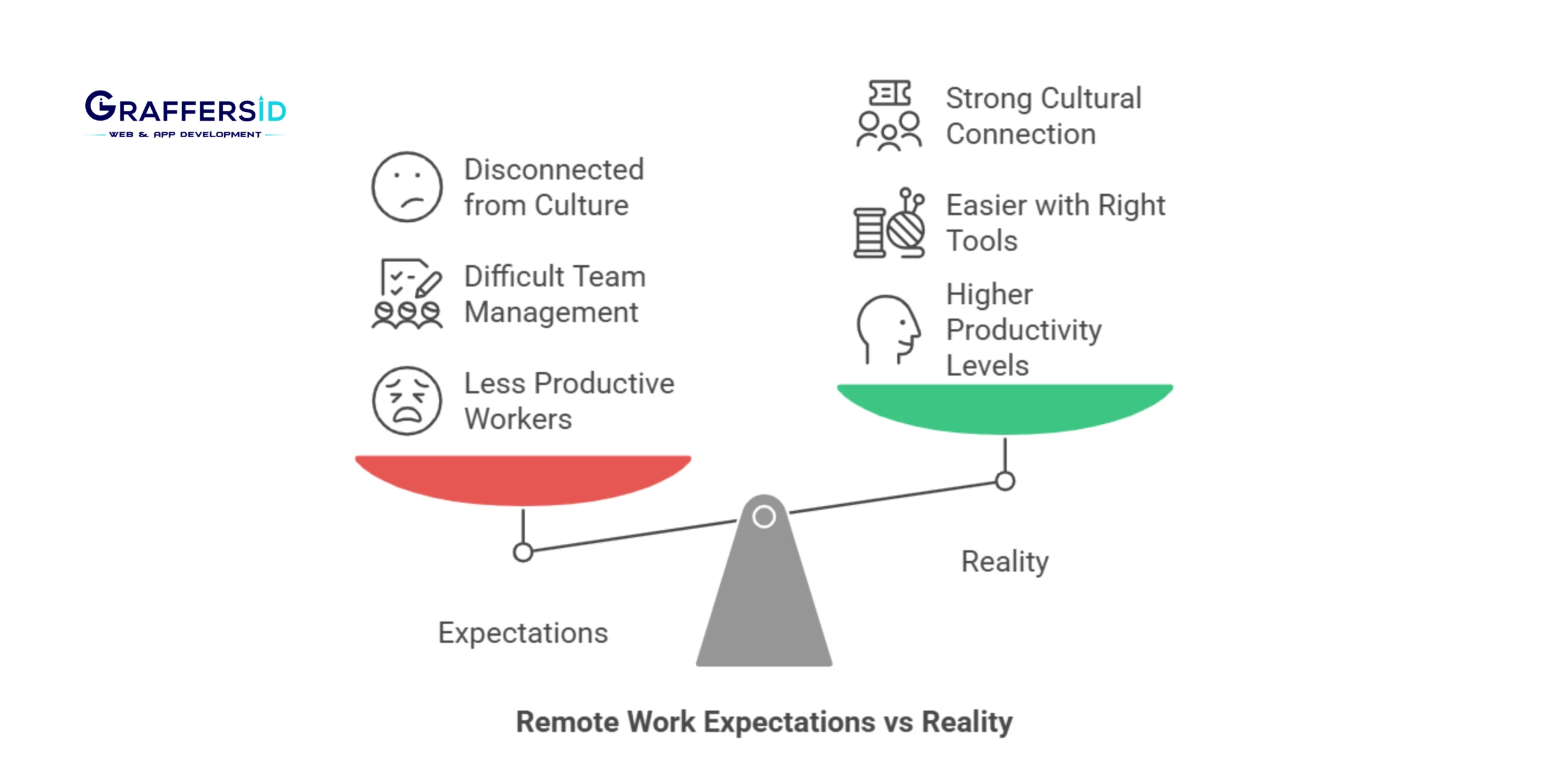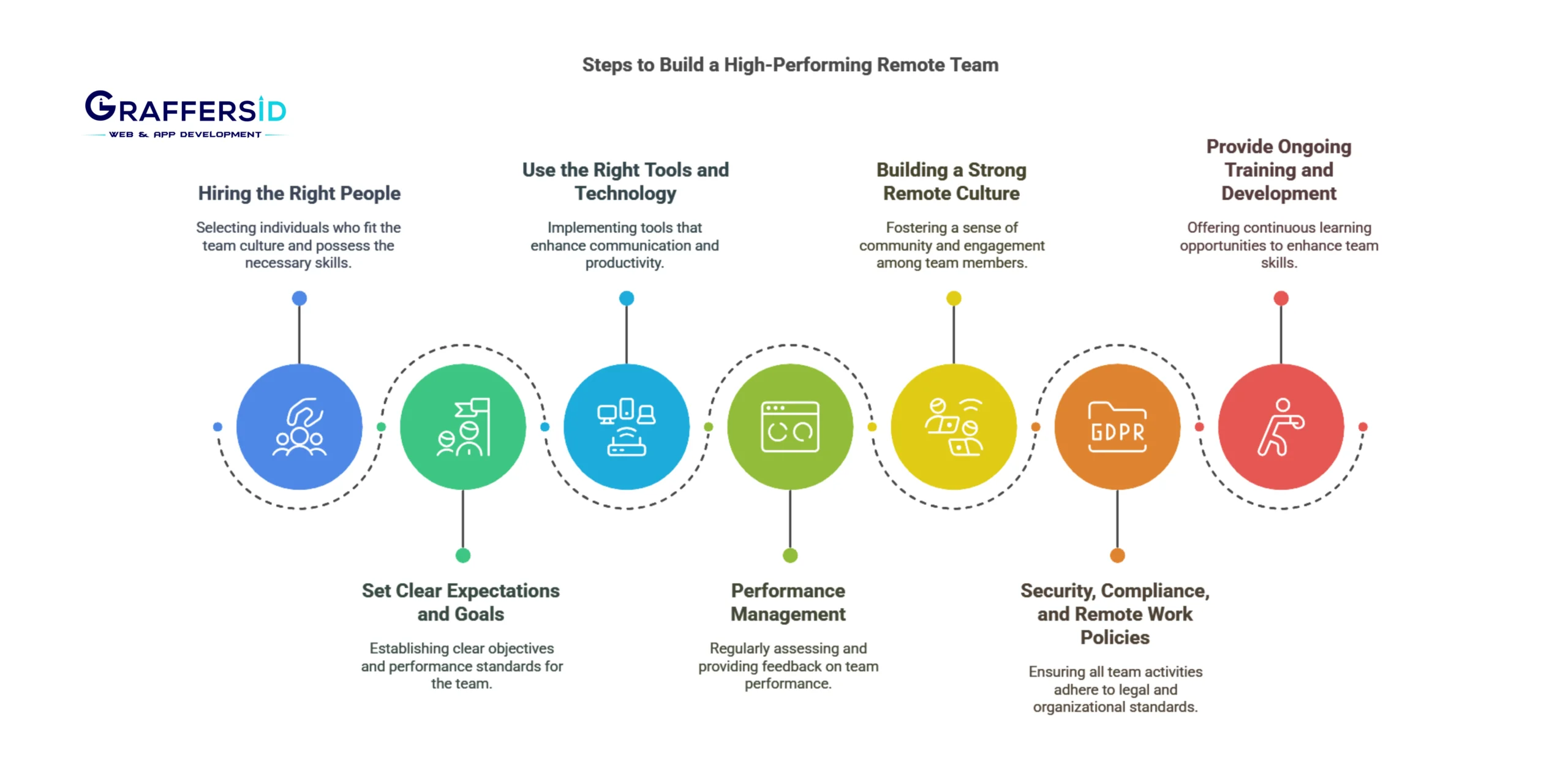For businesses all across the world, working remotely has become a new trend. Companies are depending more and more on remote workers to remain competitive as technology advances and a change in workplace culture occurs. According to studies, more than 70% of employees around the world work remotely at least once a week, and this figure is increasing.
However, many executives have misconceptions about remote teams. Some people assume that remote employees are less productive, more difficult to manage, or disconnected from the corporate culture. But, when managed properly, remote teamwork can result in increased efficiency, better work-life balance, and access to a larger talent pool.
This blog examines the common expectations vs. reality of managing remote teams and offers actionable solutions for developing a high-performing remote team.
Expectations vs Reality of Remote Work

Expectation 1: Remote Employees Are Less Productive
Reality: Research Indicates Higher Productivity
One of the most common misunderstandings regarding remote work is that employees can slow down without in-person supervision. However, numerous studies, such as one conducted by Stanford University, have revealed that remote workers are 13% more productive than their office counterparts because of fewer distractions and a more adaptable working environment.
How to Ensure Productivity in a Remote Team:
- Set clear expectations and measurable KPIs (Key Performance Indicators).
- Improve your workflow management by using productivity tools such as Slack, Asana, and Trello.
- Promote a results-driven culture instead of keeping count of hours worked.
- Implement focus time policies to help reduce meeting overload.
Microsoft Japan implemented a 4-day workweek for remote employees, resulting in a 40% productivity boost without additional working hours.
Expectation 2: Managing Remote Teams Is Extremely Difficult
Reality: Proper Tools and Strategies Make Management Easier
Managing a virtual team has unique challenges, but with the appropriate methods and tools, it can be as easy as managing a physical team.
Tips for Effective Remote Team Management:
- Schedule daily or weekly check-ins.
- Use collaboration tools such as Zoom, Microsoft Teams, and Google Meet.
- Promote a remote team culture of transparency and accountability.
GitLab, one of the world’s largest all-remote firms, effectively manages over 1,500 remote employees with a handbook-driven approach and asynchronous communication to reduce dependency on real-time interactions.
Expectation 3: Remote Employees Feel Disconnected from Company Culture
Reality: Virtual Team-building Activities Bridge the Gap
One of the issues is that remote workers feel isolated or cut off from the company culture. This is a problem, but it can be minimized through proactive engagement measures.
How to Build a Strong Remote Work Culture:
- Plan virtual team-building activities such as happy hours, puzzles, and online games.
- Through virtual recognition programs, formally acknowledge the achievements of your employees.
- Use social media platforms, such as Slack’s #random channel to promote informal discussions.
In order to encourage teamwork and collaboration, Zapier runs a program called “Pair Buddies,” which pairs employees at random for virtual coffee conversations.
Our remote developers work in an organized and flexible environment, ensuring high engagement through well-defined collaboration strategies.
Read More: How to Find and Hire Dedicated Remote Development Team?
Steps to Build a High-Performing Remote Team

1. Hiring the Right People
A remote team’s success begins with hiring employees who have the appropriate skills and abilities. Remote workers must be self-motivated, disciplined, and technically proficient.
Key Characteristics of an Efficient Remote Employee:
- Self-discipline and motivation: The ability to work autonomously without constant supervision.
- Strong communication skills: Able to explain ideas clearly via text, email, and video calls.
- Problem-solving mindset: Capable of overcoming challenges without direct managerial involvement.
- Tech savvy: Comfortable with remote work tools and platforms.
Best Hiring Practices for Remote Teams:
- Skill-based evaluations: Use practical assessments to assess a candidate’s real-world problem-solving abilities.
- Behavioral interviews: Evaluate adaptability and teamwork abilities.
- Trial project-based hiring: Short-term projects allow for performance evaluation before making long-term commitments.
GraffersID offers pre-screened, highly qualified remote developers who follow strict technical and communication requirements, ensuring the ideal fit for your team.
2. Set Clear Expectations and Goals
Without clear guidelines, remote employees may struggle with their responsibilities. Define expectations early to avoid confusion.
Best Practices for Setting Expectations:
- Clearly define job roles and deliverables.
- Use OKRs (objectives and key results) to measure success.
- Provide employees with a structured workflow.
3. Use the Right Tools and Technology
Effective remote team management requires the use of effective digital tools and technologies that facilitate communication, collaboration, and project tracking.
Essential Tools for Remote Teams:
| Category | Tools |
| Communication | Slack, Microsoft Teams, Zoom |
| Project Management | Trello, Asana, Monday.com |
| File Sharing & Collaboration | Google Drive, Dropbox, Notion |
| Time Tracking | Toggl, Time Doctor |
Strategies to Enhance Remote Collaboration & Communication:
- Limit meetings to necessary discussions to avoid burnout.
- Schedule regular virtual brainstorming sessions.
- Encourage project collaboration among different teams.
- To handle multiple time zones, use asynchronous communication.
4. Performance Management
Tracking productivity in a remote setup should focus on outcomes, not hours.
Key Strategies for Performance Tracking:
- Utilize monitoring tools such as Hubstaff, Time Doctor, and Toggl to keep everyone accountable without micromanaging.
- Regular performance check-ins to provide feedback and ensure alignment with business goals.
- Avoid excessive monitoring that can reduce employee trust.
- Focus on outcomes and project completion rather than time spent online.
Traditional Teams vs. Remote Teams
| Metric | Traditional Teams | Remote Teams |
| Work Hours | 9-to-5 tracking | Output-based |
| Productivity Evaluation | Manager feedback | KPI & OKR tracking |
GraffersID enables smooth performance tracking with customized reporting and real-time collaborative dashboards.
5. Building a Strong Remote Culture
A successful remote team needs an open culture that allows participation, cooperation, and a sense of inclusion.
Key Features of Remote Work Culture:
- Online team-building exercises: Online games, informal conversations, and interactive tasks.
- Acknowledgment and incentives: Public recognition of accomplishments through incentives and virtual shoutouts.
- Mental health initiatives: Initiatives to reduce stress, flexible work schedules, and access to counseling.
Encouraging social connections and employee engagement strategies helps employees feel connected and appreciated even when working remotely.
6. Security, Compliance, and Remote Work Policies
Remote work introduces security risks that organizations must resolve to keep sensitive information secure and comply with regulations.
Key Security Measures for Remote Teams:
- Data encryption and VPNs: Secure remote network access to company networks.
- Multi-Factor Authentication (MFA): Provides additional security for employees’ logins.
- Cybersecurity training: Train employees to deal with phishing attacks and secure internet practices.
Ensuring Compliance:
- GDPR, HIPAA, and country-specific labor regulations have to be taken into consideration while hiring from around the world.
- Remote work policies should define work expectations, security requirements, and compliance guidelines.
GraffersID provides remote developers with secured access, compliance adherence, and best cybersecurity practices.
7. Provide Ongoing Training and Development
Investing in employee growth keeps them engaged and motivated, ultimately boosting overall performance.
How To Upskill Remote Employees
- Offer access to online courses and certifications.
- Conduct regular webinars and workshops.
- Encourage peer learning and knowledge-sharing sessions.
Read More: The Future of Remote Work
Conclusion
Building an effective remote team requires strategic initiatives, clear expectations, and strong leadership. By implementing appropriate hiring practices, cultural programs, and technologies, companies can efficiently address the issues associated with remote work.
Want to develop a strong, high-performing remote team? GraffersID offers high-quality remote developers who prioritize productivity, security, and smooth cooperation. Contact us today to expand your team and hire top remote workers!





